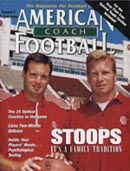AMERICAN FOOTBALL MONTHLY THE #1 RESOURCE FOR FOOTBALL COACHES
Article CategoriesAFM Magazine
|
Hot CoachesThe definition of a "hot" coach may be subjective, but so is the path to becoming one.© More from this issue His phone is ringing off the hook. A university president or an athletic director is calling, wondering if he's interested in making a big career move. The media is calling, asking if he's had any official contact or offers. Potential assistant coaches are calling, looking for a job. He's the coach at the top of the "hot" list. He's the one on everybody's list and lips. He's the media magnet, the answer to somebody's prayers, the savior in waiting, the guy who can come to your school and salvage a bad situation or take a good situation and turn it into a championship. Like they say in the Billboard Music Charts, he's climbing the charts with a bullet. He's either a head college coach who's captured the attention of the NFL, a head coach at a program where consistent success is not a given, an offensive or defensive coordinato....The full article can only be seen by subscribers.
|
|
|||||||
| HOME |
MAGAZINE |
SUBSCRIBE | ONLINE COLUMNISTS | COACHING VIDEOS |
Copyright 2025, AmericanFootballMonthly.com
All Rights Reserved





